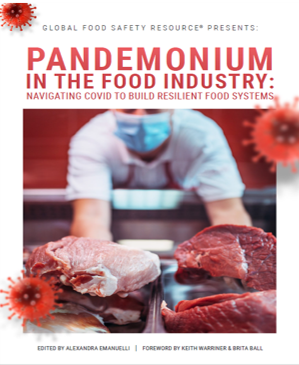3 Preventative Controls of Pathogens on Low Moisture Foods
By Keith Warriner
My previous article on low moisture foods provided a background into the food safety issues and pathogens linked to low moisture foods (LMF). Certain pathogens, most notably Salmonella and Cronobacter sakazakii, have evolved to survive under low moisture environments and have enhanced virulence in these conditions. Consequently, pathogens in the dry state represent a hazard when present in low numbers and can be challenging to inactivate. Yet, preventative control options are available and will be elaborated upon.
Control through testing
Testing is commonly applied to verify the effectiveness of preventative controls and/or as part of a hold-test-release program. As with other foods, testing has limitations concerning being representative, microbial criteria, and suitable index microbes. Such limitations are extenuated with low moisture foods given pathogens can be present at low levels (<50 CFU) yet still represent a food safety hazard. In addition, the cells are stressed, thereby prone to be inhibited by selective media, and likely to be present in a dormant, non-culturable state.
To enable the recovery of pathogens such as Salmonella and Cronobacter it is common practice to use non-selective media to undertake pre-enrichment before selective culturing. It has also been reported that the inclusion of pyruvate, glycerol, or catalase in media can enhance the recovery of pathogens from LMF. Although such media supplements enhance the recovery of pathogens it is at the price of quantification that is required for trend analysis or predictive modeling. Non-culture-based techniques such as RT-PCR and flow cytometry coupled with viability dyes (for example, propidium momoazide) can be applied. Yet, sensitivity to detect low levels and the inability of viability dyes to differentiate between VBNC vs non-viable cells continues to be a challenge.
Control through sanitation
In most outbreaks linked to low moisture foods implicating Salmonella or Cronobacter, the pathogen can be recovered from the processing environment. There are multiple routes of entry, including raw materials, dust, air, or personnel. Once within the facility, the pathogens can potentially grow if wet sanitation is performed with biofilms forming in niches (for example, damaged equipment) thereby representing continuous sources of contamination. In this regard, wet sanitation is avoided or done within contained areas to prevent moisture from spreading through the facility. Non-aqueous based methods such as hot oil, propyl alcohol, or steam are preferred. Yet, the enhanced resistance of pathogens to thermal or chemical sanitizers in the dry state can limit efficacy. A further consideration is that dust generated in low moisture environments can disseminate pathogens via the air. Hence vacuum and air filtration can help prevent the dissemination of pathogens.
There is also a food safety culture aspect to sanitizers whereby workers and management perceive LMF as safe and hence will undertake long processing runs or not be as vigilant to equipment maintenance or other Good Manufacturing Practices. Indeed, investigation reports from outbreaks frequently highlight violations in facility maintenance and handling practices.
Control through decontamination technologies
Decontamination of LMF can complement sanitation and is the preferred mean of controlling hazards. The challenge with LMFs is the sensitivity of products to water thereby requiring a non-aqueous based approach. Similarly, with the high thermal resistance of Salmonella, a balance needs to be stuck between pathogen reduction and product quality. Radiofrequency process represents an alternative to steam although the heating effect is inconsistent especially about low moisture matrices. Gas-phase treatments based on chlorine dioxide, ozone, or ethylene oxide have proven effective. However, foods such as nuts, formula milk, etc are high in antioxidants that afford protection to pathogens against oxidative sanitizers. This necessitates a high level of antimicrobial gas leading to changes in product quality along with the potential of toxic byproducts. A novel process based on the gas-phase hydroxyl radical process that uses a combination of hydrogen peroxide, ozone, and UV-C. In trials, the process has demonstrated the inactivation of Salmonella, Listeria, hepatitis A and norovirus on a broad range of LMFs thereby representing an effective preventative control step (Hasani et al., 2020, Nasheri et al., 2021).
Enhancing the food safety of low moisture foods
Low Moisture Foods represent a unique challenge in ensuring food safety and although they have the perception of being safe, the reality is that the commodity has been implicated in some of the largest outbreaks in history. Attempting to ensure raw materials are pathogen-free is problematic given that batches are often mixed and open to contamination. Similarly, processing environments are restricted in sanitation methods can be applied and very easily cause more issues than they can solve. In this respect, a focus on decontamination technologies that inactivate pathogens without altering product quality remains the preferred means of control.
About the Author:
Dr. Keith Warriner is currently a Professor within the Department of Food Science at University of Guelph, Canada. Dr. Warriner received his BSc in Food Science from the University of Nottingham, UK and PhD in Microbial Physiology from the University College of Wales Aberystwyth, UK. He was awarded the Ontario Innovation of the Year award in 2017, OCE Mind to Market award in 2018 and IAFP Food Safety Innovation of 2019 for his work with Clean Works Corp in developing surface decontamination technologies.

-
 FeaturedRisk management
The Cost of a Breach: What a Cyberattack Could Mean for Food Safety Recalls
FeaturedRisk management
The Cost of a Breach: What a Cyberattack Could Mean for Food Safety Recalls
-
 FeaturedRisk management
Securing the Food Chain: How ISO/IEC 27001 Strengthens Cybersecurity
FeaturedRisk management
Securing the Food Chain: How ISO/IEC 27001 Strengthens Cybersecurity
-
 FeaturedRisk management
Revolutionizing Food Safety Training: Breaking Out of the “Check-the-Box” Mentality
FeaturedRisk management
Revolutionizing Food Safety Training: Breaking Out of the “Check-the-Box” Mentality
-
 GFSI Standards
GFSI 2025: Building Trust, Tech-Forward Solutions, and Global Unity in Food Safety
GFSI Standards
GFSI 2025: Building Trust, Tech-Forward Solutions, and Global Unity in Food Safety
-
 FeaturedFood Safety
Integrated Pest Management: Strategies to Protect Your Brand’s Reputation
FeaturedFood Safety
Integrated Pest Management: Strategies to Protect Your Brand’s Reputation
-
 FeaturedFood Safety Culture & Training
No Open Door Policy: Challenges That Impact Pest Control in Food Processing Plants
FeaturedFood Safety Culture & Training
No Open Door Policy: Challenges That Impact Pest Control in Food Processing Plants




